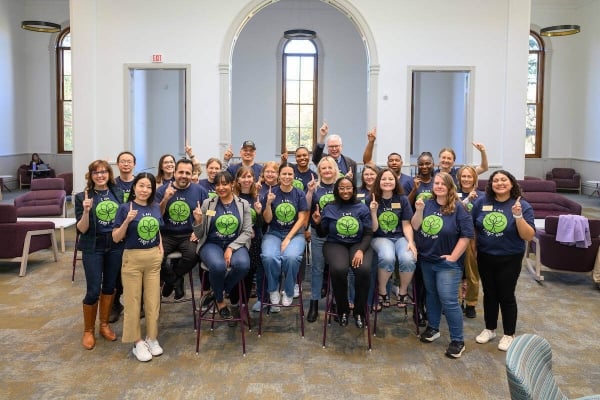Professors and staff members at the University of Notre Dame identify themselves with their T-shirts to demonstrate their support for first-generation learners.
Over half of undergraduates nationally are first-generation college students, according to 2015–16 data from NASPA. Despite making up a significant portion of learners, first-generation students often face barriers in completing their degree, with only 56 percent earning a credential after six years, compared to 40 percent of continuing-generation students.
A sense of belonging in college, one of the top predictors of student persistence, is tied to long-term outcomes after graduation.
First-generation faculty members and staff can help create a community that values and understands first-generation students, helping combat feelings of isolation, according to Forward Pathway, an education consultancy that consolidates and visualizes data about U.S. colleges. But previous research shows first-generation students are more hesitant to approach and engage with faculty members because of a lack of awareness of the benefits of these interactions.
Inside Higher Ed compiled four strategies institutions have implemented to connect first-generation community members and foster engagement between learners and personnel.
- Organize a faculty panel
As former first-generation students themselves, higher education practitioners and leaders often have advice for those navigating college for the first time. A panel discussion is one way institutions have provided insight and support to learners.
During the New Jersey college’s first-gen celebration week, Brookdale Community College faculty and administrators who were first-generation students themselves shared their academic and career journeys, challenges and tips for success with students. The event included an audience Q&A so attendees could receive advice and insight from panelists.
Similarly, Elon University in North Carolina hosted a faculty panel for first-generation students in which instructors validated the experiences of students and shared their own feelings of being first-gen.
- Create conversations
A first-generation faculty and student mixer can introduce community members and celebrate first-generation identities, as well as empower students as they chart their lives. Virginia Tech hosted an engineering-specific mixer as well as a general first-gen mixer for networking and conversations.
Colleges and universities can also match individuals to connect and share an informal dialogue on campus, perhaps sparking mentor relationships.
To celebrate National First-Generation College Celebration Week, faculty and staff members at Wichita State University could sign up to volunteer and meet with first-generation Shockers for a walk and talk experience. During the time, participants shared their college journeys. Anyone who participated in the event received a pair of WSU First-Gen Shockers socks to show off their first-gen pride.
California State Polytechnic University, Pomona, had a first-generation happy hour, First-Gen on Tap!, that connected students to mentorships with faculty and staff. Proceeds from purchases at the event also helped establish a first-generation scholarship.
- Share practitioner testimonies
Many institutions ask faculty and staff members to share reflections on their academic careers as first-generation graduates in blogs or short presentations.
Temple University collected stories from six faculty and staff members to reflect on their time in higher education and how the Philadelphia-based university supports first-generation learners. Similarly, the University of California, Davis, asked professors to reflect on how being first-gen influences their teaching.
The University of Texas at San Antonio invited faculty and administrators to participate in a First Gen Fest Speaker Series this fall, mapping out their experiences in a short speech.
- Provide first-gen merch
The first-generation identity is a hidden one, requiring students to disclose, which can be uncomfortable or nerve-racking. Universities can create visible signals for personnel to demonstrate their first-gen status and promote engagement among students.
The University of Notre Dame provided first-generation faculty and staff with T-shirts to wear while they taught during First Generation and Low Income Week and beyond to showcase their support for first-generation learners, according to a university press release.
How does your college or university celebrate first-generation student success? Share here.

